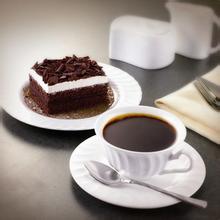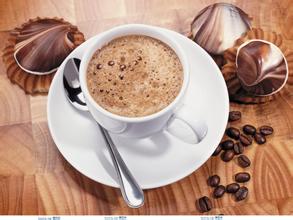Introduction to the course of how to press down the milk custard to make coffee flower
How to make coffee flower milk press down the production process skills tutorial introduction
Foaming: If you are distracted or unfocused while frothing, it is easy to cause the steam pipe to be above the surface of the milk rather than just below it. The result of this is splashing milk and producing larger milk bubbles. Of course you still get a lot of foam in the pull cup, but it will taste bad.
Too hard: hard foam looks stiff and when you pour it into coffee it doesn't mix with the coffee, but instead accumulates on top of your coffee like fluffy beaten cream. If beaten a little longer, it would be stratified, 90% runny milk, and a thick hard foam lid floating on top. When you pour it into your coffee, the milk comes out of the cup first, and you have to scoop the foam into the cup with a spoon.
Smoothness: If you do everything right, the milk looks smooth and creamy when you pour it out, a bit like yogurt. The milk and your espresso blend perfectly together, and crema colors the surface of the milk, creating the typical brown edge of cappuccino.
Re-beaten milk also often produces hard foam. The trick is to produce the right amount and quality of foam in the pull cup at the right temperature. To foam well, you have to know how fast your machine heats the amount of milk you want.
A good tip is to start frothing by not serving less than two cappuccinos at a time.
About the steam in the coffee machine:
1. After the machine has reached the correct temperature, turn on the steam switch, drain the water that will always be present in the steam pipe, and then turn off the steam switch.
2. Place the nozzle below the surface of the milk and turn on the steam. If you turn on the steam when the nozzle is above the liquid level, you get bigger bubbles, and you have to work hard to get rid of them.
3. Slowly bring the nozzle to the surface of the milk. Stop just as it breaks the surface. Now air is sucked into the milk, and you hear a typical hissing sound. If you accidentally lift the nozzle above the water, the pressurized air will blow onto the milk instead of into it, creating large bubbles.
4. At this stage, there is no doubt that you have formed small and medium-sized bubbles on the surface of the milk. Now we will try to remove them. There will be a vortex where the air blows into the milk. All bubbles on the surface are pulled into the vortex and disappear. It is important to place the nozzle in the correct position to avoid creating new bubbles.

Important Notice :
前街咖啡 FrontStreet Coffee has moved to new addredd:
FrontStreet Coffee Address: 315,Donghua East Road,GuangZhou
Tel:020 38364473
- Prev

Video course of Coffee cloth Powder manipulation-Coffee Heart shape manipulation Video processing method
Coffee cloth powder video tutorial-Coffee brocade heart-shaped manipulation video processing method ①, make sure the extraction filter bowl is clean, dry after Espresso extraction, you need to clean and dry the filter bowl, every once in a while, also do a deep cleaning to the filter bowl, first remove the filter screen from the handle, and then soak with powder and water. ②, put the ground coffee powder into a powder bowl and double Es
- Next

Honey-treated coffee beans what is the difference in flavor description of sun-washed coffee beans
Honey treatment coffee beans sun washing method flavor description what is the difference between semi-washing method: first remove the skin with water, and then go to the sun. This is a relatively new and rare method. This method is only suitable for specific areas of some countries, with a long drying period. The coffee produced by this method is sticky, and the mucus will not be fermented in the tank.
Related
- What is the meaning of lactic acid fermentation with coffee bean treatment?
- How to judge the state of foam by sound?
- How does the latte pull out the unicorn pattern? Come to get for a little trick to improve the flower pull!
- Will flower pulling affect the taste of the latte?
- Do you know the history of coffee?
- The difference between honey treatment and sun washing what is raisin honey treatment?
- What kind of milk can a novice use to make coffee foam to keep the foam longer? The correct method and skills of milking tutorial sharing
- Why do washed coffee beans taste sour? Flavor characteristics of washed Coffee
- Introduction to the skill of how to practice the size and height of water injection around the circle of hand-brewed coffee
- How do beginners practice coffee flower drawing from scratch?

